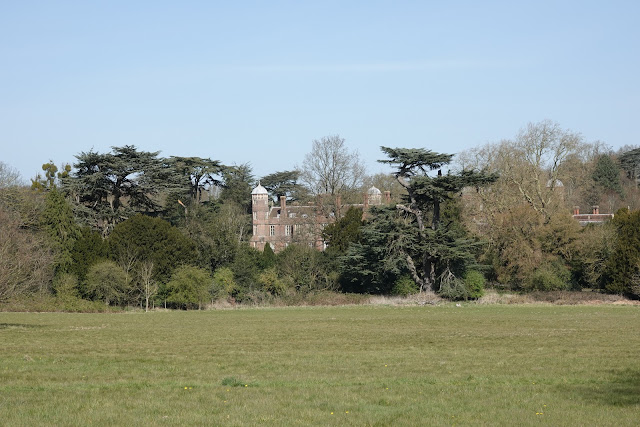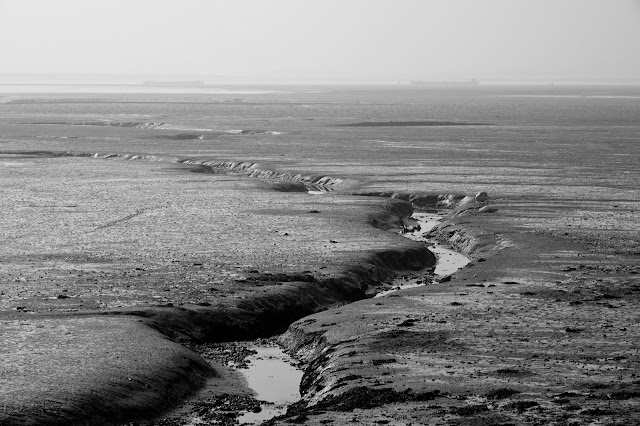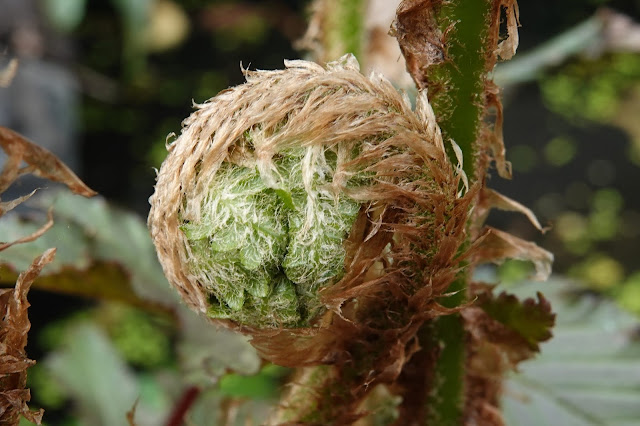Since my birthday on Monday I have been determined to get
out on foot from home and explore the remaining points on the Strood compass as
part of my daily healthy amble.
Tuesday 7th: Post breakfast saw me head up towards the end of my
road and enter to the Cobham Estate and the woods. Like everywhere that
requires foot access, it was deserted and I enjoyed a circular amble through
the Chestnut and Hornbeam pollards where Highland Cattle grazed and Peacocks, Brimstones
and high speed Orange Tips flitted between Violets, Bluebells, Primroses and Celandines
along with a host of very tiny Andrena chrysosceles (Hawthorn
Mining Bee) and numerous Dark–edged
Beeflies.
 |
| There were six 'new' Sweet Chestnuts growing strongly from the long fallen body of this veteran tree |
 |
| The Darnley Mausoleum |
 |
| A very gnarly and almost naked English Oak |
 |
| Can you smell that? |
 |
| And the Highland Cattle have been stripping what looks like Sycamores |
 |
| Brimstone |
 |
| Dark–edged
Beefly |
 |
| Hawthorn
Mining Bee - Andrena chrysosceles |
Buzzards mewed overhead and Green and Great Spotted
Woodpeckers were vocal along with Nuthatch, Treecreeper and the usual tits. I
saw Hawfinch, Willow and Marsh Tits here when I first visited 20 years ago but
only Marsh Tit recently and I could not find one at all this time.
 |
| Empty Golf Course |
Wednesday 8th took me on a loop out of Strood via
Broomhill Park which has a radiomast that I can see from my house, down through
some young orchards and then up some lanes to Higham and back via Rede Common.
 |
| The view from Broomhill Park - my house is just out of view to the left and down a bit! |
Mistle Thrushes are a part of urban Strood life and there
are at least four pairs in my road and another couple nearer the old A2. One was singing nicely by the empty sports
centre.
 |
| Mistle Thrush |
Banks of sweet smelling Alexanders line the lanes and they
are not even in full flower yet and the scent of Hawthorn and Apple percolated
down wherever you walked.
Song Thrushes, Blackbirds, Chiffchaffs, Blackcaps, Wrens and
Robins were the main songsters and I could not find any other warblers at all
and the lack of any fieldside hedges is always disappointing to see.
Skylarks were singing in every field though and plump
Woodpigeons were feeding where they probably shouldn’t.
 |
| Woodpigeon |
Verges by houses were better for wildlife with a few hovers
and bumbles and I found my first flowering Green Alkanet and Garlic
Mustard. An exposed sandy bank on a
roadside held a nice colony of Andrena flavipes and with no one around I could
sit in the road and take some shots.
 |
| Green Alkanet |
 |
Garlic
Mustard
|
 |
| Hedge remnant and Greater Stitchwort |
 |
| Andrena flavipes |
A male Swallow was serenading the sky outside some stable where
some fine horses were paddocked and I checked for Wheatears and Ouzels but only
found Starlings and Blackbirds.
 |
| Swallow |
 |
| Swallow |
The views
out across the North Kent marshes were expansive and hazed by the sunshine and
the glow of a trillion acres of Oilseed and you could just see vessels heading
in and out of the Thames and a shimmer of Southend beyond.
Topped Poplars lined some fields and the new leaves shone
copper red in the sunshine while another stand had lustrous lime green young
leaves.
 |
| Poplar |
 |
| Poplar |
I heard Nuthatches and Goldcrests near Higham Church and discovered a
colony of Anthophora plumipes in a bank at the end of Telegraph Hill with the
cleptoparasitic bee Melecta albifrons in attendance.
 |
| Higham Church |
 |
| Anthophora plumipes |
 |
| Melecta albifrons |
It was then down the litter strewn Crutches Lane past the ancient
preserved orchard and then up onto Rede Common and back home with a views over
to Rochester Castle and some dancing Speckled Woods amongst the trees.
 |
| Old Apple trees |
 |
| Queen Wasp |
 |
| Dandelion |
 |
| Rochester Cathedral and Castle |
 |
| Speckled Wood |
Thursday 9th: I ventured a little further and
headed down the Medway, following the Saxon Shore Way for an early stroll. The tide was out which made the path
available and I crunched my way through flints, glass, pottery, brick, seaweed
and old oyster shells alongside Hoo Wood Fort towards the empty marinas
beyond.
 |
| Upnor Castle |
 |
| The Saxon Shore Way |
 |
| Great Crested Grebe |
 |
| Goldfinch |
 |
| WWII Pill Box |
 |
| Hoo Wood Fort |
 |
| Hoo Wood Fort |
 |
| Hoo Wood Fort |
Oystercatchers and Redshanks
called along the margins and Herring, Lesser Black-backed and Black-headed
Gulls picked over the tideline for scraps with packs of marauding Carrion Crows.
 |
| Oystercatcher |
 |
| Redshank |
Med Gulls were a constant feature although seeing them as
they drifted over high in pairs was tricky and only their evocative ‘cow’ calls
gave them away. The low light on the mud and boats and hulks was magical and other than the birds there was no sound bar the fizzing of the mud, and the buzz of an errant bee. This coupled with the smell of mud and iodine tang of salty seaweed made it a very tranquil place to be.
 |
| Med Gulls |
 |
| Med Gulls |
 |
| Kings North Power Station Jetty Crane |
Green Woodpeckers yaffled from every wood as did Chiffchaffs
and Blackcaps but only when I got to Abbots Pool SSSI did I find two Reed Buntings, a single Sedge
and two shouty Cetti’s Warblers. There were
more ouzelless paddocks to check but the numbers of singing Skylarks was
encouraging and a single Avocet was a nice bonus. A Water Rail kipped from the reedbed.
 |
| The Avocet |
 |
| Abbots Pool SSSI |
 |
| There was a good population of House Sparrows |
I came back via Hoo St Werburgh church where Goldcrests and
glossy Starlings sang but the subsequent oilseed rape fields were barren of
life and made my eyes sting.
 |
| Hoo St Werburgh church |
 |
| Starling |
A Grey Wagtail greeted me in song at the end of my circuit
which, as ever, made me smile.
The afternoon was spent in the garden with the first
Blackcap in full song and a fine female Peregrine overhead freaking out the
local Sparrowhawks. Helophilus pendulus
was added to the hoverfliy list for the year and all the others seen on Monday
put in an appearance.
 |
| A through the foliage Peregrine |
 |
| Helophilus pendulus |
 |
| Helophilus pendulus |
 |
| Helophilus pendulus |
My Hawthorns were now in full scented flower with many, what
I now know to be, Hawthorn Mining Bees in attendance. Speckled Woods rested on
the Marsh Marigold leaves in the afternoon sun.
 |
| Speckled Wood |
 |
| Micro Stanley on Tulip |
 |
| Great Tit drinking at at Hoverquarium |
 |
| Hawthorn |
I keep feeling like I should be ‘doing stuff’ but the garden
is basically done now, I have no work, the weather is glorious, I have cold
beers in the fridge and Med Gulls keep flying over my house. What more do I need?
 |
| Med Gulls |
Friday 10th and Saturday 11th: And as such I
spent next two days lounging like a sluggish lizard in my garden, reading my
book, updating my World Bird List in my mammoth Clements tick book and
discovering that Lesser Nighthawk was my thousandth species, supping the
occasional bevy and generally staring either at flies around my pond or at the
unblemished largely bird free skies above.
Someone told me that apparently I was engaging in something
called ‘relaxation’?
Sunday 12th: Two days of slothing around was
enough to send me off walking again this morning on a local loop (notionally to
look for some oeufs). I headed up onto Rede Common again where there seemed to
be even more Blackcaps and Chiffchaffs before heading once again into the peripheral
farmland and orchards discovering two more footpaths in the process. Ornithologically
it was quiet but the walk was good for me – there are no flat walks around
Strood!
 |
| Luminous young Horse Chestnut leaves dangle like half opened umbrellas |
 |
| Oak flowers are just starting to appear |
 |
| And have you ever looked at a Sycamores flowers? |
 |
| Kentish Strawberries in the making |
I failed to find any eggs and thus banished myself to the
garden in shame where I even managed to find a couple of jobs to do in between fly,
frog and sky watching.
 |
| male Nursery Web Spider Pisaura mirabilis |
 |
| Calliphora vicina |
 |
| Eristalis pertinax |
 |
| Eristalis pertinax |
 |
| I played with some macro |
 |
| Common Frogs |
 |
| Common Frogs |
At least there
was a bit of cloud bubbling up in the late afternoon and it made picking out
the super high Buzzards a little easier as they cruised over and I was pleased
but not too surprised to see my first Hobby of the year and the male Peregrine performing
some stunning aerial manoeuvres.
 |
| Buzzard |
My garden nemesis is Red Kite. Everyone sees them over their gardens nowadays but in 20 years in
Strood I have never seen one. There had
been dozens moving throughout the south-east in recent days but they were
mostly coastal but this time they were being picked up along the northern strip
so perhaps it would be my day? As it was,
the first one almost snuck through from the south before turning west and
heading up the road at height. I was elated
and there may have been an air punch and a fairly loud ‘yeeesss!’
 |
| Red Kite #1 |
Half an hour later another Kite appeared in my airspace and
was a little lower than the first and this one even got hassle from the local
Buzzards and then, an hour later I was told that one had gone west over Chatham
and sure enough I picked that one up too as a micro-kite way up against the
blue about 15 minutes later.
 |
| Red Kite #2 |
 |
| Red Kite #3 |
So, zero to three Kites in 90 minutes. A fine way to end my week and leaving me on
59 species for the garden list since lockdown on the 23rd March.
Tomorrow is Bank Holiday Monday and the weather is turning... I wonder what will blow my way?























































































































No comments:
Post a Comment